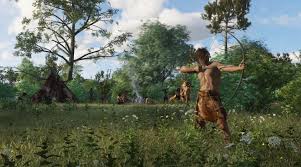Essay Composition On – Mesolithic Hunters – For W.B.C.S. Examination.
These relationships must have continually varied from region to region as a result of environmental and other factors. Strikingly, such patterns of interaction persisted in the subcontinent throughout the remainder of the prehistoric period and long into the historic, with vestiges still discernible in some areas in the 20th century.
Thus, chronologically, the Mesolithic cultures cover an enormous span. In Sri Lanka several Mesolithic sites have been dated to as early as about 30,000 years ago, the oldest yet recorded for the period in South Asia. At the other end of the subcontinent, in caves of the Hindu Kush in northern Afghanistan, evidence of occupation dating to between 15,000 and 10,000 BCE represents the Epipaleolithic Stage, which may be considered to fall within the Mesolithic. The domestication of sheep and goats is thought to have begun in this region and period.
Many of the caves and rock shelters of central India contain rock paintings depicting a variety of subjects, including game animals and such human activities as hunting, honey collecting, and dancing. This art appears to have developed from Upper Paleolithic precursors and reveals much about life in the period. Along with the art have come increasingly clear indications that some of the caves were sites of religious activity.
Neolithic agriculture in the Indus valley and Baluchistan
The Indo-Iranian borderlands form the eastern extension of the Iranian plateau and in some ways mirror the environment of the Fertile Crescent (the arc of agricultural lands extending from the Tigris-Euphrates river system to the Nile valley) in the Middle East. Across the plateau, lines of communication existed from early antiquity, which would suggest a broad parallelism of developments at both the eastern and western extremities. During the late 20th century, knowledge of early settlements on the borders of the Indus system and Baluchistan was revolutionized by excavations at Mehrgarh and elsewhere.
The group of sites at Mehrgarh provides evidence of some five or six thousand years of occupation comprising two major periods, the first from the 8th through the 6th millennium BCE and the second from the 5th through the 4th (and possibly the 3rd) millennium. The earliest evidence occurs in a mound 23 feet (7 metres) deep discovered beneath massive alluvial deposits. Two subphases of Period I are apparent from the mound artifacts.
Phase IA, dating to the 8th–7th millennium BCE, was an aceramic (i.e., lacking pottery) Neolithic occupation. The main tools were stone blades, including lunates and triangles, some probably mounted in wooden hafts with bitumen mastic; a relatively small number of ground stone axes have been found. Domestication of wheat and barley apparently reached the area sometime during this phase, as did that of sheep and goats, although the preponderance of gazelle bones among the animal remains suggests continued dependence on hunting. Houses of mud brick date from the beginning of this phase and continue throughout the occupation. Accompaniments to the simple burial of human remains included shell or stone-bead necklaces, baskets, and occasionally young caprids (both sheep and goats) slaughtered for the purpose.
Phase 1B, dating to the 7th–6th millennium, is characterized by the emergence of pottery and improvements in agriculture. By the beginning of Phase 1B, cattle (apparently Bos indicus, the Indian humped variety) had come to predominate over game animals, as well as over sheep and goats. A new type of building, the small regular compartments of which identify it almost certainly as a granary, first appeared during this phase and became prevalent in Period II, indicating the frequent occurrence of crop surpluses. Burial took a more elaborate form—a funerary chamber was dug at one end of a pit, and, after inhumation, the chamber was sealed by a mud brick wall. From the latter phase of Period I also come the first small, hand-modeled female figurines of unburned clay.
The Period I evidence at Mehrgarh provides a clear picture of an early agricultural settlement exhibiting domestic architecture and a variety of well-established crafts. The use of seashells and of various semiprecious stones, including turquoise and lapis lazuli, indicates the existence of trade networks extending from the coast and perhaps also from Central Asia.
Striking changes characterize Period II. It appears that some major tectonic event took place at the beginning of the period (c. 5500 BCE), causing the deposition of great quantities of silt on the plain, almost completely burying the original mound at Mehrgarh. Nearly all features of the earlier culture persisted, though in altered form. There was an increase in the use of pottery. The granary structures proliferated, sometimes on a larger scale. The remains of several massive brick walls and platforms suggest something approaching monumental architecture. Evidence appears of several new crafts, including the first examples of the use of copper and ivory. The area of the settlement appears to have grown to accommodate an increasing population.
While the settlement at Mehrgarh merits extensive consideration, it should not be perceived as a unique site. There are indications (not yet fully explored) that other equally early sites may exist in other parts of Baluchistan and elsewhere on the Indo-Iranian borderlands.
In the northern parts of the Indus system, the earliest known settlements are substantially later than Mehrgarh. For example, at Sarai Khola (near the ruins of Taxila in the Pakistan Punjab) the earliest occupation dates from the end of the 4th millennium and clearly represents a tradition quite distinct from that of contemporary Sind or Balochistan, with ground stone axes and plain burnished red-brown pottery. The same is the case at Burzahom in the Vale of Kashmir, where deep pit dwellings are associated with ground stone axes, bone tools, and gray burnished pottery. Evidence of the “aceramic Neolithic” stage is reported at Gufkral, another site in the Kashmir region, which has been dated by radiocarbon to the 3rd millennium and later.
Please subscribe here to get all future updates on this post/page/category/website


 +919674493673
+919674493673  mailus@wbcsmadeeasy.in
mailus@wbcsmadeeasy.in







































































































